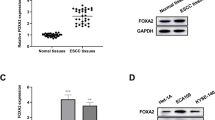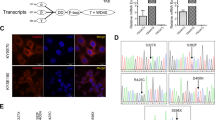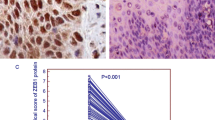Abstract
The human far upstream element (FUSE) binding protein 1 (FUBP1) belongs to an ancient family which is required for proper regulation of the c-Myc proto-oncogene. Although c-Myc plays an important role in development of various carcinomas, the relevance of FUBP1 and their contribution to esophageal squamous cell carcinoma (ESCC) development remain unclear. In this study, we aimed to investigate the relationship between FUBP1 and c-Myc as well as their contribution to ESCC development. Western blot and immunohistochemical analyses were performed to evaluate FUBP1 expression. Coimmunoprecipitation analysis was performed to explore the correlation between FUBP1 and c-Myc in ESCC. In addition, the role of FUBP1 in ESCC proliferation was studied in ESCC cells through knocking FUBP1 down. The regulation of FUBP1 on proliferation was confirmed by Cell Counting Kit-8 (CCK-8) assay, flow cytometric assays, and clone formation assays. The expressions of FUBP1 and c-Myc were both upregulated in ESCC tissues. In addition to correlation between expression of FUBP1 and tumor grade, we also confirmed the correlation of FUBP1, c-Myc, and Ki-67 expression by twos. Moreover, upregulation of FUBP1 and c-Myc in ESCC was associated with poor survival. FUBP1 was confirmed to activate c-Myc in ESCC tissues and cells. FUBP1 was demonstrated to promote proliferation of ESCC cells. Moreover, downregulation of both FUBP1 and c-Myc was confirmed to inhibit proliferation of ESCC cells. Our results indicated that FUBP1 may potentially stimulate c-Myc expression in ESCC and its expression may promote ESCC progression.







Similar content being viewed by others
References
Jemal A, Siegel R, Ward E, Murray T, Xu J, Thun MJ. Cancer statistics, 2007. CA Cancer J Clin. 2007;57(1):43–66.
Zhang L, Wu YD, Li P, Tu J, Niu YL, Xu CM, et al. Effects of cyclooxygenase-2 on human esophageal squamous cell carcinoma. World J Gastroenterol WJG. 2011;17(41):4572–80. doi:10.3748/wjg.v17.i41.4572.
Avigan MI, Strober B, Levens D. A far upstream element stimulates c-myc expression in undifferentiated leukemia cells. J Biol Chem. 1990;265(30):18538–45.
Duncan R, Bazar L, Michelotti G, Tomonaga T, Krutzsch H, Avigan M, et al. A sequence-specific, single-strand binding protein activates the far upstream element of c-myc and defines a new DNA-binding motif. Genes Dev. 1994;8(4):465–80.
Chien HL, Liao CL, Lin YL. FUSE binding protein 1 interacts with untranslated regions of Japanese encephalitis virus RNA and negatively regulates viral replication. J Virol. 2011;85(10):4698–706. doi:10.1128/JVI.01950-10.
Cao G, Kuriyama S, Du P, Sakamoto T, Kong X, Masui K, et al. Complete regression of established murine hepatocellular carcinoma by in vivo tumor necrosis factor alpha gene transfer. Gastroenterology. 1997;112(2):501–10.
Yamanaka T, Shiraki K, Sugimoto K, Ito T, Fujikawa K, Ito M, et al. Chemotherapeutic agents augment TRAIL-induced apoptosis in human hepatocellular carcinoma cell lines. Hepatology. 2000;32(3):482–90. doi:10.1053/jhep.2000.16266.
Sheikh MS, Huang Y. Death receptors as targets of cancer therapeutics. Curr Cancer Drug Targets. 2004;4(1):97–104.
Ohira M, Ohdan H, Mitsuta H, Ishiyama K, Tanaka Y, Igarashi Y, et al. Adoptive transfer of TRAIL-expressing natural killer cells prevents recurrence of hepatocellular carcinoma after partial hepatectomy. Transplantation. 2006;82(12):1712–9. doi:10.1097/01.tp.0000250935.41034.2d.
Sturm I, Stephan C, Gillissen B, Siebert R, Janz M, Radetzki S, et al. Loss of the tissue-specific proapoptotic BH3-only protein Nbk/Bik is a unifying feature of renal cell carcinoma. Cell Death Differ. 2006;13(4):619–27. doi:10.1038/sj.cdd.4401782.
Rabenhorst U, Beinoraviciute-Kellner R, Brezniceanu ML, Joos S, Devens F, Lichter P, et al. Overexpression of the far upstream element binding protein 1 in hepatocellular carcinoma is required for tumor growth. Hepatology. 2009;50(4):1121–9. doi:10.1002/hep.23098.
Malz M, Weber A, Singer S, Riehmer V, Bissinger M, Riener MO, et al. Overexpression of far upstream element binding proteins: a mechanism regulating proliferation and migration in liver cancer cells. Hepatology. 2009;50(4):1130–9. doi:10.1002/hep.23051.
Singer S, Malz M, Herpel E, Warth A, Bissinger M, Keith M, et al. Coordinated expression of stathmin family members by far upstream sequence element-binding protein-1 increases motility in non-small cell lung cancer. Cancer Res. 2009;69(6):2234–43. doi:10.1158/0008-5472.CAN-08-3338.
Belletti B, Nicoloso MS, Schiappacassi M, Berton S, Lovat F, Wolf K, et al. Stathmin activity influences sarcoma cell shape, motility, and metastatic potential. Mol Biol Cell. 2008;19(5):2003–13. doi:10.1091/mbc.E07-09-0894.
Zhang J, Chen QM. Far upstream element binding protein 1: a commander of transcription, translation and beyond. Oncogene. 2013;32(24):2907–16. doi:10.1038/onc.2012.350.
Nie Z, Hu G, Wei G, Cui K, Yamane A, Resch W, et al. c-Myc is a universal amplifier of expressed genes in lymphocytes and embryonic stem cells. Cell. 2012;151(1):68–79. doi:10.1016/j.cell.2012.08.033.
Ding Z, Liu X, Liu Y, Zhang J, Huang X, Yang X, et al. Expression of far upstream element (FUSE) binding protein 1 in human glioma is correlated with c-Myc and cell proliferation. Mol Carcinog. 2013. doi:10.1002/mc.22114.
Wang Y, Yang S, Ni Q, He S, Zhao Y, Yuan Q, et al. Overexpression of forkhead box J2 can decrease the migration of breast cancer cells. J Cell Biochem. 2012;113(8):2729–37. doi:10.1002/jcb.24146.
Zhu H, Wang Q, Hu C, Zhang W, Quan L, Liu M, et al. High expression of survivin predicts poor prognosis in esophageal squamous cell carcinoma following radiotherapy. Tumour Biol J Intern Soc Oncodevelop Biol Med. 2011;32(6):1147–53. doi:10.1007/s13277-011-0217-y.
Dong C, Yuan T, Wu Y, Wang Y, Fan TW, Miriyala S, et al. Loss of FBP1 by snail-mediated repression provides metabolic advantages in basal-like breast cancer. Cancer Cell. 2013;23(3):316–31. doi:10.1016/j.ccr.2013.01.022.
Engidawork E, Afjehi-Sadat L, Yang JW, Slavc I, Lubec G. Protein chemical identification and characterization of the human variants of far upstream element binding protein in medulloblastoma DAOY cell line. Int J Oncol. 2006;29(3):721–36.
Niforou KM, Anagnostopoulos AK, Vougas K, Kittas C, Gorgoulis VG, Tsangaris GT. The proteome profile of the human osteosarcoma U2OS cell line. Cancer Genomics Proteomics. 2008;5(1):63–78.
Zheng Y, Miskimins WK. Far upstream element binding protein 1 activates translation of p27Kip1 mRNA through its internal ribosomal entry site. Int J Biochem Cell Biol. 2011;43(11):1641–8. doi:10.1016/j.biocel.2011.08.001.
Weber A, Kristiansen I, Johannsen M, Oelrich B, Scholmann K, Gunia S, et al. The FUSE binding proteins FBP1 and FBP3 are potential c-myc regulators in renal, but not in prostate and bladder cancer. BMC Cancer. 2008;8:369. doi:10.1186/1471-2407-8-369.
He L, Liu J, Collins I, Sanford S, O’Connell B, Benham CJ, et al. Loss of FBP function arrests cellular proliferation and extinguishes c-myc expression. EMBO J. 2000;19(5):1034–44. doi:10.1093/emboj/19.5.1034.
Acknowledgments
This study was supported by the National Natural Science Foundation of China (No. 81272708).
Author information
Authors and Affiliations
Corresponding authors
Ethics declarations
Conflicts of interest
None
Additional information
Lei Yang and Jun-ya Zhu contributed equally to this work.
Rights and permissions
About this article
Cite this article
Yang, L., Zhu, Jy., Zhang, Jg. et al. Far upstream element-binding protein 1 (FUBP1) is a potential c-Myc regulator in esophageal squamous cell carcinoma (ESCC) and its expression promotes ESCC progression. Tumor Biol. 37, 4115–4126 (2016). https://doi.org/10.1007/s13277-015-4263-8
Received:
Accepted:
Published:
Issue Date:
DOI: https://doi.org/10.1007/s13277-015-4263-8




